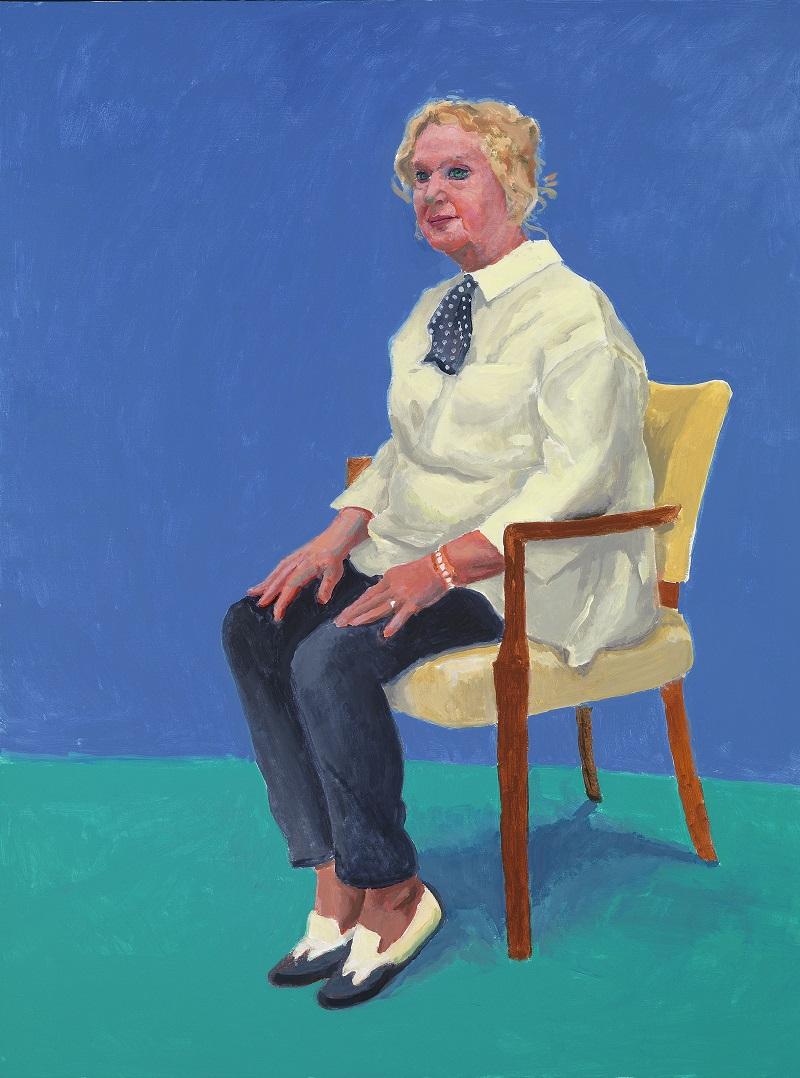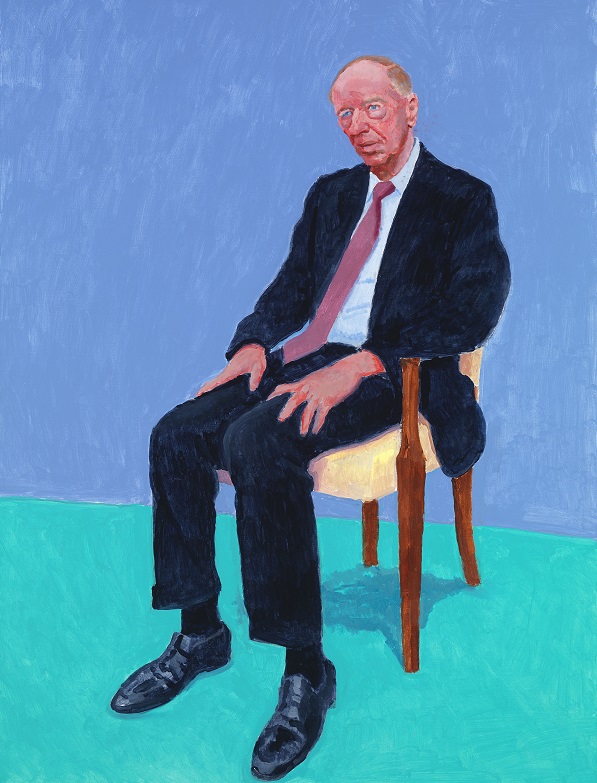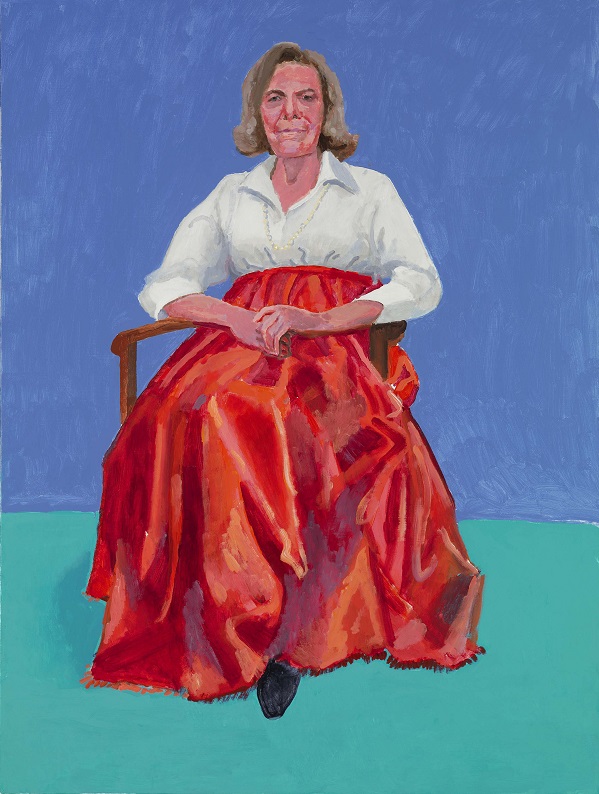David Hockney RA: 82 Portraits and 1 Still-life, Royal Academy | reviews, news & interviews
David Hockney RA: 82 Portraits and 1 Still-life, Royal Academy
David Hockney RA: 82 Portraits and 1 Still-life, Royal Academy
An ongoing series of portraits has served as a tonic during difficult times, but its value is more personal than artistic

The opening image of this new David Hockney exhibition – a sketchily painted portrait of a seated man, slumping heavily forward, his head buried in his hands – could be a portrait of Brexit despair.
In this sense, this opening portrait, dated precisely 11th, 12th, 13th July 2013, can also be regarded as a self-portrait, the agitated hatching of the background and discordant zig-zag pattern of the rug illustrating Hockney’s and J-P’s shared state of wretchedness, while the composition (perhaps unconsciously) echoes Van Gogh’s Sorrowing Old Man.
 The contrast between the grief-stricken figure, the dazzling Californian colours, and the rapid execution, however, sparked a new idea. Hockney embarked on what would be a more public cycle of intimate portraits, each using the same 48” x 36” upright canvas, each produced over a similar timeframe (the precise dates are included in the titles), and each using the same coloured backdrop. A second portrait of his close friend Bing McGilvray, whose bulky form fills a canvas that can’t quite accommodate him, illustrates Hockney’s maxim about portraiture, that one can never "quite get the whole person".
The contrast between the grief-stricken figure, the dazzling Californian colours, and the rapid execution, however, sparked a new idea. Hockney embarked on what would be a more public cycle of intimate portraits, each using the same 48” x 36” upright canvas, each produced over a similar timeframe (the precise dates are included in the titles), and each using the same coloured backdrop. A second portrait of his close friend Bing McGilvray, whose bulky form fills a canvas that can’t quite accommodate him, illustrates Hockney’s maxim about portraiture, that one can never "quite get the whole person".
After 10 more works the idea of a series crystallised, and the project is still ongoing. The subjects are Hockney’s surrogate family of friends and intimates (many of them art world luminaries), some of his own family, and a few children of friends, all painted over three days (not too onerous for the sitter – one day off work and a weekend, as Hockney suggested – although busy folk like Jacob Rothschild (pictured above right) and Larry Gagosian could only spare two).
So now we have 82 portraits – and (rather coyly) one still-life – all drawn in charcoal directly on to canvas and then built up in acrylics in the same methodical way, during seven-hour bursts of activity. Clearly Hockney has turned to ritual as an aid to recovery and artistic reinvention. Only the first portrait displays any raw emotion, but all share scale (the exception is a double portrait of twins), a turquoise-green and blue ground, and the same simple chair with its butter-toned upholstery. The chair was positioned on a platform, so that the eye-level of sitter and artist matched, and the light is unvarying (all were painted in Hockney’s LA studio).
This is the undoubted strength of the project and exhibition – the series is presented as one coherent whole, rather like a giant Pop collage. The Academy has hung the works uniformly against a rich Venetian-red backdrop, the room colour normally reserved for Old Masters. This makes the colours zing, and gives the pictures maximum formal and colouristic impact.
 Hockney has worked from life, relying on the decisiveness and immediacy of the drawn line. This gives the series a freshness, a sense of real time, and a strange mute energy that could never quite be captured by a photograph. We know that Hockney is gregarious, but also very deaf, so that although he loves parties he now prefers intimate one to ones. This series provides him with that opportunity on a continual basis, although the process of painting is intense and largely silent. Thus Hockney responds more to body language than features animated by exchange.
Hockney has worked from life, relying on the decisiveness and immediacy of the drawn line. This gives the series a freshness, a sense of real time, and a strange mute energy that could never quite be captured by a photograph. We know that Hockney is gregarious, but also very deaf, so that although he loves parties he now prefers intimate one to ones. This series provides him with that opportunity on a continual basis, although the process of painting is intense and largely silent. Thus Hockney responds more to body language than features animated by exchange.
The exhibition has an undoubted impact, due largely to its Pop splash of colour and its repetitive nature. The eye naturally searches for rhythm and variations among the ruddy-faced sitters, provided largely by the way they occupy the chair (one slings his leg nonchalantly over the arm) and the variety of clothes they have chosen for the occasion: the glint of Larry Gagosian’s expensive watch; the shiny black shoes of Jonathan Mills; the billowing red taffeta of Rita Pynoos’s skirt (pictured above left). The still-life of fruit and vegetables, against the same background, provides a humorous counterpoint.
But by half way, I’m flagging; I am distracted by the flatness of many of the characterisations and the unevenness of Hockney’s handling of the acrylic medium (including the new gel acrylic that he is learning to use). There is the occasional portrait that really grabs: I particularly liked the detached portrait of 11-year-old Holden Schmidt, who was apparently resentful at sitting during his school holidays. Another portrait that triumphs against the odds is that of 73-year-old Celia Birtwell (once Mrs Clarke), the subject of many celebrated Hockney portraits. Here there is a real sense of shared history and intimacy over decades (main picture).
The rather splendid book that serves as an exhibition catalogue, shows Hockney standing with a montage of all 83 paintings, demonstrating that he wants this series to be regarded as a single body of work. He also believes that "The 20-hour exposure is not only visual. These people are revealed." Whether he has succeeded in both respects is questionable. For Hockney, however, it is clear that this return to the portrait format he loves has brought creative renewal and a welcome burst of sanity.
- David Hockney RA: 82 Portraits and 1 Still-Life at the Royal Academy until 2 October
rating
Explore topics
Share this article
more Visual arts
 Yinka Shonibare: Suspended States, Serpentine Gallery review - pure delight
Weighty subject matter treated with the lightest of touch
Yinka Shonibare: Suspended States, Serpentine Gallery review - pure delight
Weighty subject matter treated with the lightest of touch
 Jane Harris: Ellipse, Frac Nouvelle-Aquitaine MÉCA, Bordeaux review - ovals to the fore
Persistence and conviction in the works of the late English painter
Jane Harris: Ellipse, Frac Nouvelle-Aquitaine MÉCA, Bordeaux review - ovals to the fore
Persistence and conviction in the works of the late English painter
 Sargent and Fashion, Tate Britain review - portraiture as a performance
London’s elite posing dressed up to the nines
Sargent and Fashion, Tate Britain review - portraiture as a performance
London’s elite posing dressed up to the nines
 Zineb Sedira: Dreams Have No Titles, Whitechapel Gallery review - a disorientating mix of fact and fiction
An exhibition that begs the question 'What and where is home?'
Zineb Sedira: Dreams Have No Titles, Whitechapel Gallery review - a disorientating mix of fact and fiction
An exhibition that begs the question 'What and where is home?'
 Yoko Ono: Music of the Mind, Tate Modern review - a fitting celebration of the early years
Acknowledgement as a major avant garde artist comes at 90
Yoko Ono: Music of the Mind, Tate Modern review - a fitting celebration of the early years
Acknowledgement as a major avant garde artist comes at 90
 Unravel: The Power and Politics of Textiles in Art, Barbican review - the fabric of dissent
An ambitious exploration of a neglected medium
Unravel: The Power and Politics of Textiles in Art, Barbican review - the fabric of dissent
An ambitious exploration of a neglected medium
 When Forms Come Alive, Hayward Gallery review - how to reduce good art to family fun
Seriously good sculptures presented as little more than playthings or jokes
When Forms Come Alive, Hayward Gallery review - how to reduce good art to family fun
Seriously good sculptures presented as little more than playthings or jokes
 Entangled Pasts 1768-now, Royal Academy review - an institution exploring its racist past
After a long, slow journey from invisibility to agency, black people finally get a look in
Entangled Pasts 1768-now, Royal Academy review - an institution exploring its racist past
After a long, slow journey from invisibility to agency, black people finally get a look in
 Barbara Kruger, Serpentine Gallery review - clever, funny and chilling installations
Exploring the lies, deceptions and hyperbole used to cajole, bully and manipulate us
Barbara Kruger, Serpentine Gallery review - clever, funny and chilling installations
Exploring the lies, deceptions and hyperbole used to cajole, bully and manipulate us
 Richard Dorment: Warhol After Warhol review - beyond criticism
A venerable art critic reflects on the darkest hearts of our aesthetic market
Richard Dorment: Warhol After Warhol review - beyond criticism
A venerable art critic reflects on the darkest hearts of our aesthetic market
 Dineo Seshee Raisibe Bopape: (ka) pheko ye / the dream to come, Kiasma, Helsinki review - psychic archaeology
The South African artist evokes the Finnish landscape in a multisensory installation
Dineo Seshee Raisibe Bopape: (ka) pheko ye / the dream to come, Kiasma, Helsinki review - psychic archaeology
The South African artist evokes the Finnish landscape in a multisensory installation
 Paul Cocksedge: Coalescence, Old Royal Naval College review - all that glitters
An installation explores the origins of a Baroque masterpiece
Paul Cocksedge: Coalescence, Old Royal Naval College review - all that glitters
An installation explores the origins of a Baroque masterpiece

Add comment